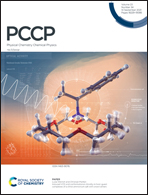Electronic structures and properties of dianionic pentacarbonyls [TM(CO)5]2− (TM = Cr, Mo, W)†
Abstract
Density functional theory (DFT) calculations were employed to study the stabilities, electronic structures, and vibrational and bonding properties of dianionic pentacarbonyls [TM(CO)5]2− (TM = Cr, Mo, W). A D3h symmetry structure with singlet state was found to be the ground state and C–O stretching vibrational frequencies range from 1719 to 1766 cm−1, which are in excellent agreement with the experimental observations. The calculation results on bond dissociation energy for the CO loss revealed their stabilities. By employing energy decomposition analysis (EDA), the bonding nature between TM2− and (CO)5 was disclosed, in which the [TM(d)]2−→(CO)5 π backdonations contribute largely to the orbital interactions while σ donation from the lone pair of CO to metal contributes moderately. Compared with those in the isoelectronic neutral hexacarbonyls TM(CO)6, the π backdonations are obviously larger in [TM(CO)5]2− because there are two extra electrons in (n − 1)d AOs of the center transition metal.
![Graphical abstract: Electronic structures and properties of dianionic pentacarbonyls [TM(CO)5]2− (TM = Cr, Mo, W)](/en/Image/Get?imageInfo.ImageType=GA&imageInfo.ImageIdentifier.ManuscriptID=D1CP01592C&imageInfo.ImageIdentifier.Year=2021)


 Please wait while we load your content...
Please wait while we load your content...